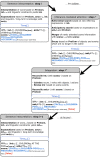Extending Situated Language Comprehension (Accounts) with Speaker and Comprehender Characteristics: Toward Socially Situated Interpretation
- PMID: 29416517
- PMCID: PMC5787543
- DOI: 10.3389/fpsyg.2017.02267
Extending Situated Language Comprehension (Accounts) with Speaker and Comprehender Characteristics: Toward Socially Situated Interpretation
Abstract
More and more findings suggest a tight temporal coupling between (non-linguistic) socially interpreted context and language processing. Still, real-time language processing accounts remain largely elusive with respect to the influence of biological (e.g., age) and experiential (e.g., world and moral knowledge) comprehender characteristics and the influence of the 'socially interpreted' context, as for instance provided by the speaker. This context could include actions, facial expressions, a speaker's voice or gaze, and gestures among others. We review findings from social psychology, sociolinguistics and psycholinguistics to highlight the relevance of (the interplay between) the socially interpreted context and comprehender characteristics for language processing. The review informs the extension of an extant real-time processing account (already featuring a coordinated interplay between language comprehension and the non-linguistic visual context) with a variable ('ProCom') that captures characteristics of the language user and with a first approximation of the comprehender's speaker representation. Extending the CIA to the sCIA (social Coordinated Interplay Account) is the first step toward a real-time language comprehension account which might eventually accommodate the socially situated communicative interplay between comprehenders and speakers.
Keywords: Coordinated Interplay Account; comprehender; psycholinguistics; real-time language processing; social context; sociolinguistics; speaker.
Figures


References
-
- Altmann G. T., Kamide Y. (2007). The real-time mediation of visual attention by language and world knowledge: linking anticipatory (and other) eye movements to linguistic processing. J. Mem. Lang. 57 502–518. 10.1016/j.jml.2006.12.004 - DOI
-
- Baaren R. B., Holland R. W., Steenaert B., van Knippenberg A. (2003). Mimicry for money: behavioral consequences of imitation. J. Exp. Soc. Psychol. 39 393–398. 10.1016/S0022-1031(03)00014-3 - DOI
-
- Bar-Tal D. (2006). “Bridging between micro and macro perspective in social psychology,” in Bridging Social Psychology: The Benefits of Transdisciplinary Approaches, ed. Van Lange P. A. M. (Mahwah, NJ: Lawrence Erlbaum; ), 341–346.
Publication types
LinkOut - more resources
Full Text Sources
Other Literature Sources

